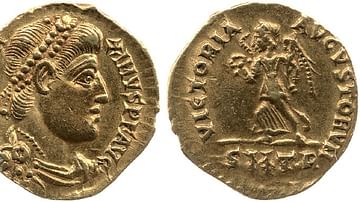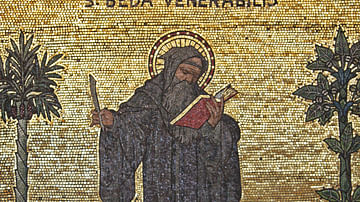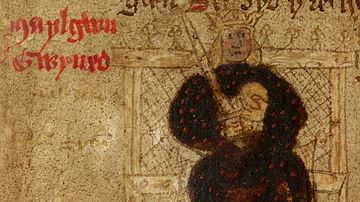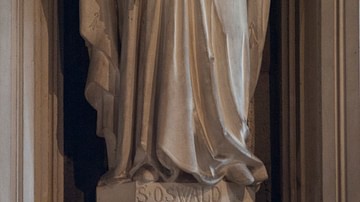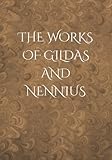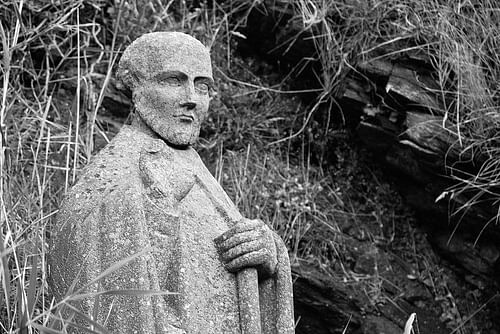
Gildas (c. 500-570 CE) was a Romano-British monk, known primarily for a work entitled De Excidio et Conquestu Britanniae, translated as On the Ruin and Conquest of Britain. Gildas' work is a polemical sermon recounting British history while also rebuking the British kings and clergy of his own lifetime. While little is known of Gildas himself, it is generally accepted that he was writing at some point in the mid-6th century CE. He probably lived near western Britain, modern-day Wales and Cornwall. Later in life, he emigrated to Brittany in what is now northwestern France. There he joined many of his fellow Britons fleeing the oncoming Germanic invaders. Gildas founded there the monastery which came to be known as St. Gildas de Rhuys and he came to be venerated as a saint; at times referred to as Saint Gildas Sapiens, or Saint Gildas the Wise.
Life of Gildas
The year of Gildas' birth is generally dated to no earlier than c. 500 CE. Gildas himself claims that he was born in the same year that the Battle of Mount Badon was fought. He claims in his own writing that it had been roughly 40 years since the battle. This suggests that he was roughly 40 years old at the time. The location of his birth is unknown and has been the subject of debate. Very little is known about Gildas himself, and almost none of the tradition surrounding his life can be accepted with certainty. The geography of On the Ruin and Conquest of Britain seems to suggest that he was living and writing somewhere in close proximity to the western British kingdoms in modern-day Wales and Cornwall. Scholars have noted that he reveals little about his own identity, perhaps for fear of reprisal for his criticisms. It is believed by scholars that On the Ruin and Conquest of Britain was written in the mid-sixth century, possibly in the 540s CE.
Several sources for Gildas' life have survived from the ancient and medieval periods. These include two hagiographic accounts, written in the 9th and 12th centuries CE respectively. Gildas also appears in works such as the Annales Cambriae ('The Annals of Wales'), a collection of sources for ancient and early medieval Welsh history. This account also dates to centuries after Gildas' death. Much of the information provided in these accounts is purely legendary. It is known that at some point Gildas emigrated to Brittany, joining many Romano-British who fled the Anglo-Saxons. It was here that he founded the monastery of St. Gildas de Rhuys. His death is generally dated at c. 570 CE.
Aside from On the Ruin of Britain, several other surviving fragments of writing are attributed to Gildas. There are several letter fragments and a penitential. He was a prominent figure in the generations following his death. His authority in monastic matters was sufficient for him to warrant the attention of Columbanus in a letter written to Pope Gregory the Great. He is also cited at length both in the Irish canonical collection known as the Collectio canonum Hibernensis ('Irish Collection of Canon Law') and in Bede's Historia Ecclesiastica Gentis Anglorum ('Ecclesiastical History of the English People').
On the Ruin & Conquest of Britain
On the Ruin and Conquest of Britain is a lengthy sermon consisting of three main sections:
- A chronicle of the history of Roman Britain.
- A diatribe against five British kings ruling in areas of Western Britain during Gildas' lifetime.
- A sermon criticizing the British clergy of the 6th century CE and offering them examples from the Bible of proper behavior for men of their occupation.
In Part I of his work, Gildas provides an explanatory preface for his writing. In his preface, Gildas explains that his purpose in writing is to illustrate the sins of his people and to show them a better way. He then begins a narrative of the history of his homeland from the Roman conquest to the Britain of his lifetime. He does not provide a coherent historical narrative, but rather offers a series of events illustrating sin and divine punishment in the history of Roman Britain. This section features distinct episodes throughout the history of Roman Britain. Gildas begins with the conquest of Britain by the Roman Empire. He details various rebellions, the rise of Christianity and subsequent persecutions, and an examination of the decline of Roman Britain. Here Gildas concerns himself with a series of both political and religious rebellions. He mentions the rebellions of the British queen Boudicca and later of the Roman general Magnus Maximus. He also discusses the persecutions of early Christians, early British martyrs, and heresies such as Arianism. Gildas tries to show in this narrative that the wickedness of the Britons repeatedly results in their own folly.
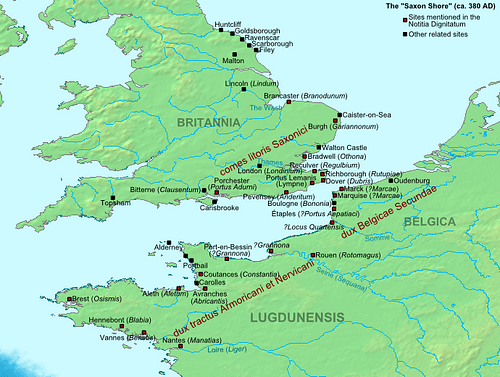
Gildas traces the ultimate decline of Roman Britain from the episode of Magnus Maximus. He blames Maximus for bringing virtually the whole of Roman military strength with him in his misguided rebellion. Gildas provides perhaps the earliest recorded mention of the Groans of the Britons, or the account of the appeals of the citizens of Roman Britain to the continent for aid against Picts and Scots raiders. According to Gildas, the appeal was made to one Agitius, who is generally identified with the general Flavius Aetius. When Aetius turned them down, Gildas writes that the British authorities were forced to hire out Saxon mercenaries to help them fight off their encroaching neighbors. It was these Saxon mercenaries, according to Gildas, who revolted against their British hosts. This episode began a string of conquests of the country that lasted until the very year of Gildas' birth. Gildas repeatedly compares the Saxons to wild beasts, referring to them as wolves and dogs among other metaphors. Gildas claims that a battle at a place called Mons Badonicus, or Mount Badon, was a major victory for the Britons under Ambrosius Aurelianus in the year of his own birth. From this battle on, there was peace for roughly 40 years until the time of his writing.
Part II is a vigorous denouncement of five different British kings ruling in different areas in western Britain at the time of Gildas' writing. The first king named is Constantine of Dumnonia (modern-day Cornwall). Gildas derides him and refers to him as the 'tyrannical whelp of that unclean lioness of Dumnonia.' The lioness in question is never herself named. The second king is Aurelius Caninus (Canonus), also a 'lion's whelp' who commits 'horrible murders, fornications, and adulteries.' The next is Vortipor of the Demetae, 'the naughty son of a good King.' The fourth is Cuneglasus (Cuneglasse) of Dineirth, singled out for mistreatment of his wife as well as for rapacious behavior regarding his subjects. Finally, Gildas names Maglocunus (Maelgwn) 'Dragon of the Island' (Island of Anglesey), a violent usurper who apparently overthrew his own uncle to become king. Gildas calls them tyrants and laments that they are more interested in terrorizing their own people than in defending the lands of their ancestors from the marauding Saxons. The portraits of these five different kings display significant character flaws both in their personal lives and in their treatment of their subjects.
The remainder of the work is a lengthy reproval of the British clergy of Gildas' day. Gildas reproaches his fellow clergymen for a number of faults including drunkenness, greed, and a general fixation on lay pursuits. He provides a number of Biblical examples to illustrate the righteous path to his fellow churchmen. Aside from identifying himself with Jeremiah in his preface, Gildas goes through a veritable catalog of Old Testament prophets in his warning to the British. Samuel, Hosea, Amos, Zephaniah, Haggai, and Malachi are all quoted and examined as warnings to the clergy to lead better and more holy lives in addition to other Biblical figures.
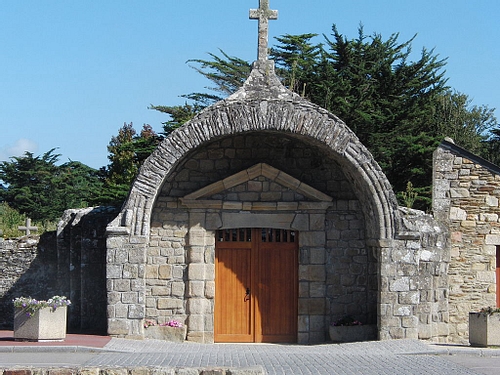
Legacy of Gildas
Gildas is one of the only sources from late Roman Britain to shed any light on the early movements of the 5th and 6th century CE Germanic invaders. Gildas was seen as an authoritative figure in monastic matters for generations following his death. He is mentioned in a letter written by Columbanus to Pope Gregory the Great and he is also cited as an authority in the Collectio canonum Hibernensis, probably compiled in the 7th or 8th century CE. His relics were venerated at Rhuys for generations before they were transferred to Berry in the 10th century CE. Though his chronicle of the Germanic migrations to Britain can hardly be accepted as history today, his work loomed large over later generations of Anglo-Saxon leaders, both lay and clerical, particularly when it was used by Bede for the early parts of his own history.


